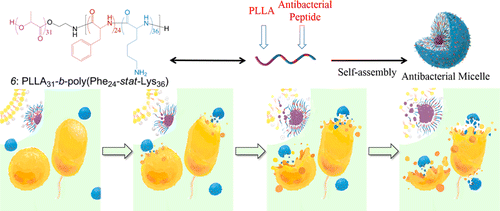Preparation and Antibacterial Mechanism Insight of Polypeptide-Based Micelles with Excellent Antibacterial Activities
作者:Yuejing Xi, Tao Song, Songyao Tang, Nuosha Wang, and Jianzhong Du* 时间:2016-11-02 点击数:

Abstract:
Traditional antibiotics usually sterilize in chemical ways, which may lead to serious drug resistance. By contrast, peptide-based antibacterial materials are less susceptible to drug resistance. Herein we report the preparation of an antibacterial peptide-based copolymer micelle and the investigation of its membrane-penetration antibacterial mechanism by transmission electron microscopy (TEM). The copolymer is poly(L-lactide)-block-poly(phenylalanine-stat-lysine) [PLLA31-b-poly(Phe24-stat-Lys36)], which is synthesized by ring-opening polymerization. The PLLA chains form the core, whereas the polypeptide chains form the coronas of the micelle in aqueous solution. This micelle boasts excellent antibacterial efficacy against both Grampositive and Gram-negative bacteria. Furthermore, TEM studies clearly reveal that the micelles pierce and then destroy the cell membrane of the bacteria. We also compared the advantages and disadvantages of two general methods for measuring the Minimal Inhibitory Concentration (MIC) values of antibacterial micelles. Overall, this study provides us with direct evidence for the antibacterial mechanism of polypeptide-based micelles and a strategy for synthesizing biodegradable antibacterial nanomaterials without antibiotic resistance.
文章链接:Biomacromolecules 2016, 17, 3922–3930.